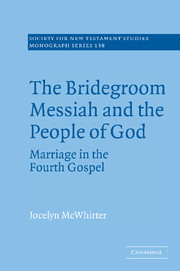Book contents
- Frontmatter
- Contents
- Acknowledgments
- List of abbreviations
- 1 Allusions to biblical texts about marriage
- 2 Echoes of Scripture, representative figures, and messianic exegesis
- 3 The revelation of the bridegroom-Messiah: allusions to Jeremiah 33:10–11 and Genesis 29:1–20
- 4 The glorification of the bridegroom-Messiah: allusions to Song 1:12 and Song 3:1–4
- 5 The bridegroom-Messiah of Psalm 45 in the Song of Songs, Jeremiah 33:10–11, and Genesis 29:1–20
- 6 Hearing the echoes
- 7 Conclusion
- Bibliography
- Scripture index
- Index of ancient commentators
- Index of modern commentators
2 - Echoes of Scripture, representative figures, and messianic exegesis
Published online by Cambridge University Press: 22 September 2009
- Frontmatter
- Contents
- Acknowledgments
- List of abbreviations
- 1 Allusions to biblical texts about marriage
- 2 Echoes of Scripture, representative figures, and messianic exegesis
- 3 The revelation of the bridegroom-Messiah: allusions to Jeremiah 33:10–11 and Genesis 29:1–20
- 4 The glorification of the bridegroom-Messiah: allusions to Song 1:12 and Song 3:1–4
- 5 The bridegroom-Messiah of Psalm 45 in the Song of Songs, Jeremiah 33:10–11, and Genesis 29:1–20
- 6 Hearing the echoes
- 7 Conclusion
- Bibliography
- Scripture index
- Index of ancient commentators
- Index of modern commentators
Summary
Echoes of Scripture in the Fourth Gospel
We cannot begin the process of identifying and interpreting John's allusions to marriage texts without some idea of what an allusion is and how it works. Wendell V. Harris offers a clear and concise definition in his Dictionary of Concepts in Literary Criticism and Theory. According to Harris, an allusion is “the evocation of a person, character, place, event, idea, or portion of text through quotation (exact or approximate), implicit reference through similarity, explicit reference, or echo. Such evocation or suggestion is intended to lead the reader to bring some aspect of the referent to bear at that point of the originating text.” He further explains that “allusion is presumed to enrich meaning, pleasure being derived from the economy with which it does so.” In Harris' terms, the proposed allusions to be evaluated in this study evoke a portion of Israel's Scriptures by means of implicit reference through similarity.
This definition begs for immediate qualification. Who inscribes implicit references, and for whom do those references evoke a portion of a text? Who leads what reader to associate the referent with the originating text? In order to understand an allusion, it is first necessary to define its author and audience.
Once we have defined author and audience, we can then follow the basic approach suggested by Harris' two-part definition. First, we must identify the allusion.
- Type
- Chapter
- Information
- The Bridegroom Messiah and the People of GodMarriage in the Fourth Gospel, pp. 21 - 45Publisher: Cambridge University PressPrint publication year: 2006



